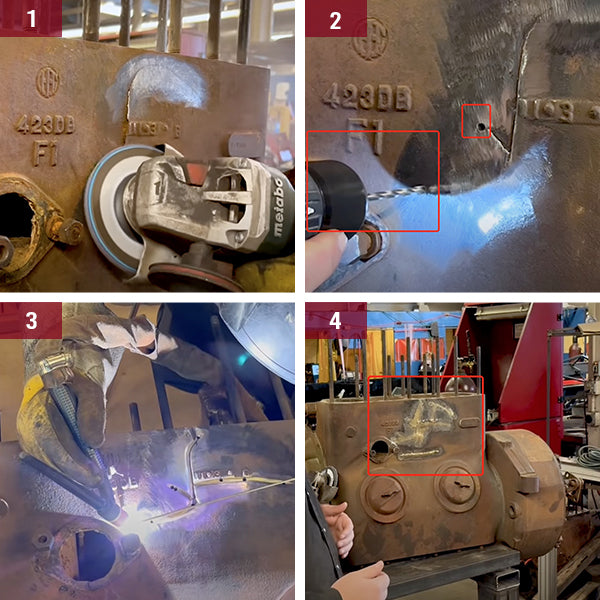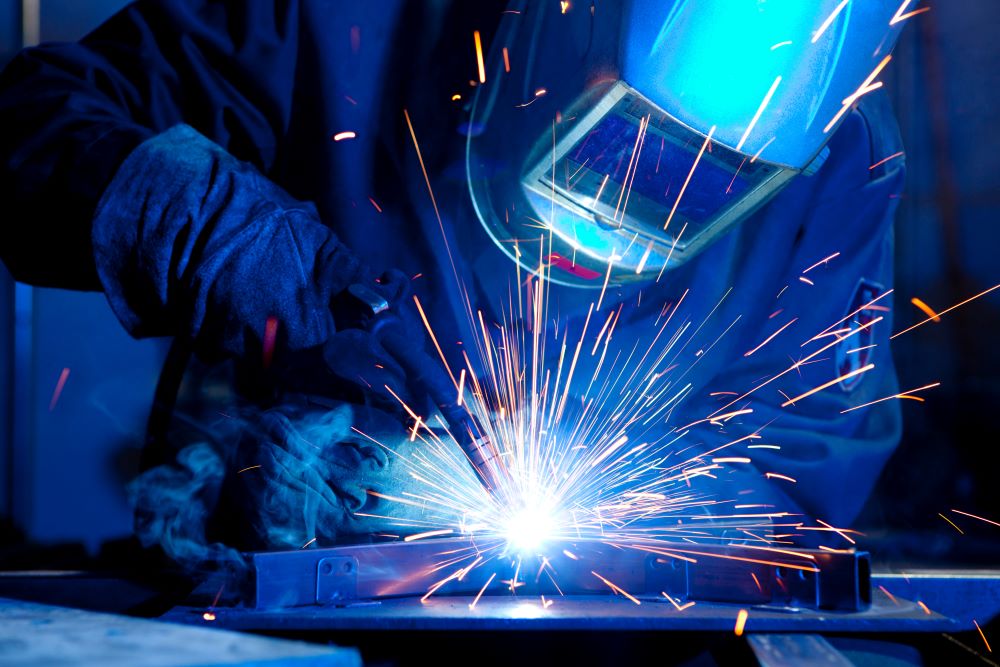Everything about Welding: Key Insights Into Techniques and Ideal Practices for Success
Welding incorporates a variety of strategies, each suited for particular materials and applications. Understanding these techniques, such as GMAW, SMAW, and TIG, is essential for accomplishing optimal results. In addition, the appropriate tools and safety methods can not be neglected. As preparation and troubleshooting play critical functions in the welding procedure, grasping these components can greatly improve the high quality of the final product. What are the key variables that ensure an effective weld?
Understanding Different Welding Strategies
Welding methods incorporate a variety of methods, each suited to particular applications and materials. Amongst one of the most usual strategies are Gas Steel Arc Welding (GMAW), Shielded Steel Arc Welding (SMAW), and Tungsten Inert Gas Welding (TIG) GMAW, additionally referred to as MIG welding, is preferred for its speed and convenience, making it optimal for slim products. SMAW, or stick welding, is preferred for its simplicity and effectiveness in outdoor settings, especially with thicker metals. TIG welding provides precision and control, making it suitable for complex job and non-ferrous steels (Montana Mobile Welding and Repair Belgrade Fabrication). Each method has its unique benefits and considerations, allowing welders to choose the very best technique based upon the job's requirements, material kind, and wanted outcomes. Understanding these methods is necessary for effective welding
Necessary Welding Equipment and Tools
While numerous welding techniques call for specific abilities, the appropriate equipment and tools are similarly important for attaining top quality outcomes. Crucial welding devices includes welding makers, which vary depending on the method-- such as MIG, TIG, or stick welding. Safety equipment, consisting of handwear covers, aprons, and helmets, warranties security and comfort during the process. Furthermore, clamps and components help safeguard products in place, guaranteeing precision in welds. Consumables like welding rods, wire, and securing gas are also essential parts that affect the high quality of the weld. Devices such as cutters and grinders promote surface prep work and post-weld finishing, adding to an expert outcome. Buying high-quality tools eventually enhances the effectiveness and effectiveness of welding tasks.
Security Practices in Welding
Correct safety methods are important in the welding sector to protect workers from possible risks. Welders must wear appropriate individual safety equipment (PPE), including headgears with correct shading, handwear covers, and flame-resistant clothing. Ample air flow is important to lower exposure to damaging fumes and gases generated during the welding procedure. Additionally, employees ought to be learnt the correct handling of welding devices to avoid crashes. Fire security actions, such as maintaining combustible products away from the welding location and having fire extinguishers readily offered, are needed. Normal evaluations of devices and workspaces can aid determine potential risks before they cause accidents. By sticking to these security practices, welders can create a much safer working setting and reduce dangers related to their trade.
Preparing Products for Welding
Preparing products for welding is a vital action that substantially influences the quality and honesty of the end product (Belgrade). Correct prep work includes cleaning the surfaces to get rid of contaminants such as dirt, corrosion, and oil, which can jeopardize the weld. Methods such as grinding, fining sand, or making use of solvents are commonly employed to achieve a clean surface. Furthermore, making certain that the products mesh comfortably is crucial; voids can cause weak welds. It's likewise vital to think about the positioning and positioning of the parts, as this will certainly impact the simplicity of welding and the final result. Finally, selecting the suitable filler product and making certain compatibility with the base metals is vital for accomplishing strong, resilient welds
Tips for Getting High-Quality Welds
Achieving high-grade welds needs attention to information and adherence to ideal techniques throughout the welding procedure. Correct joint preparation is vital, making certain surfaces are free and clean from impurities. Picking the appropriate filler material and welding strategy based upon the base metals is vital for excellent bonding. Maintaining consistent traveling speed and angle while welding can prevent problems and promote harmony. Additionally, regulating warmth input is essential; extreme warm can cause bending and compromised joints. If essential, frequently checking the welds throughout the procedure allows for instant changes. Lastly, employing ideal post-weld therapies, such as cleansing and anxiety relief, can enhance the sturdiness and integrity of the weld, eventually guaranteeing an effective result.
Fixing Common Welding Issues
Welding typically presents challenges that can influence the top quality and stability of the end product. Common problems such as porosity, inconsistent weld beads, and overheating can arise, each calling for particular repairing techniques. Comprehending these troubles is important for welders to enhance their skills and attain perfect results.
Porosity Problems Discussed
Porosity can often be neglected, it continues to be a crucial concern in welding that can compromise the honesty of a completed product. Porosity describes the visibility of little gas pockets within the weld grain, which can lead and damage the joint to early failing. This problem usually occurs from pollutants, moisture, or incorrect securing gas protection during the welding procedure. To minimize porosity, welders should verify that the base products are clean and dry, make use of appropriate shielding gases, and keep regular welding parameters. Frequently evaluating the equipment and atmosphere can likewise help identify prospective issues before they manifest in the weld. Resolving porosity successfully is crucial for accomplishing solid, sturdy welds that fulfill quality standards.

Irregular Weld Beads
Inconsistent weld beads can considerably affect the top quality and strength of a finished product. Various variables add to this concern, consisting of improper travel speed, inaccurate amperage settings, and inconsistent electrode angles. When the welder relocates as well quickly, a bead may appear narrow and lack infiltration, while moving too slowly can trigger too much buildup. In addition, using the incorrect amperage can lead to either damaging or extreme spatter, both of which concession weld integrity. The welder's strategy, such as irregular lantern motion, can additionally lead to uneven grain appearance. To alleviate these problems, welders should concentrate on keeping steady, controlled motions and ensuring appropriate devices settings to achieve harmony in their welds. Uniformity is crucial to attaining Clicking Here strong and reputable welds.
Overheating and Warping Issues
Excessive heat during the welding procedure can lead to significant getting too hot and buckling problems, impacting the architectural you can try this out honesty of the work surface. These troubles frequently show up as distortion, which can endanger positioning and fit-up, making additional assembly testing. Aspects adding to overheating consist of the selection of welding parameters, such as voltage and take a trip rate, in addition to the kind of product being welded. To reduce these concerns, welders must maintain regular travel rate and proper warmth input while keeping an eye on the workpiece temperature level. In addition, preheating or post-weld heat therapy can help ease stress and anxieties triggered by rapid air conditioning - Belgrade. Normal inspection and adherence to ideal practices are vital in avoiding getting too hot and making certain the long life and reliability of bonded structures
Regularly Asked Concerns
What Are the Occupation Opportunities in the Welding Market?
The welding industry uses varied profession chances, including settings as welders, educators, inspectors, and engineers. Specialists can operate in production, building and construction, aerospace, and automotive fields, gaining from strong need and competitive salaries in different functions.
Just How Can I Boost My Welding Speed Without Sacrificing High Quality?
To improve welding speed without compromising quality, one need to practice efficient methods, maintain devices, maximize settings, and enhance hand-eye sychronisation. Routine training and seeking responses can additionally significantly add to attaining much faster, premium welds.
What Qualifications Are Readily Available for Welders?
Countless qualifications exist for welders, consisting of those from the American Welding Society (AWS), the National Facility for Building And Construction Education And Learning and Study (NCCER), and different industry-specific organizations. These credentials improve employability and demonstrate skill effectiveness.
Just How Does Welding Affect the Features of Metals?
Welding affects the properties of steels by changing their microstructure, which can cause adjustments in stamina, ductility, and firmness. Heat input and cooling rates during the procedure significantly influence these material characteristics.
Can I Bonded Dissimilar Metals Together?
